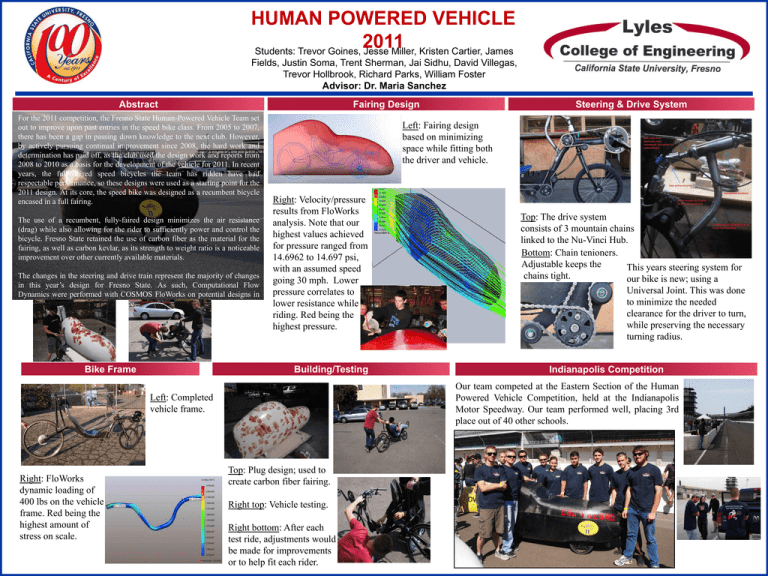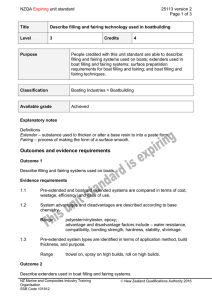HUMAN POWERED VEHICLE 2011
advertisement

HUMAN POWERED VEHICLE 2011 Students: Trevor Goines, Jesse Miller, Kristen Cartier, James Fields, Justin Soma, Trent Sherman, Jai Sidhu, David Villegas, Trevor Hollbrook, Richard Parks, William Foster Advisor: Dr. Maria Sanchez Fairing Design Abstract For the 2011 competition, the Fresno State Human-Powered Vehicle Team set out to improve upon past entries in the speed bike class. From 2005 to 2007, there has been a gap in passing down knowledge to the next club. However, by actively pursuing continual improvement since 2008, the hard work and determination has paid off, as the club used the design work and reports from 2008 to 2010 as a basis for the development of the vehicle for 2011. In recent years, the fully-faired speed bicycles the team has ridden have had respectable performance, so these designs were used as a starting point for the 2011 design. At its core, the speed bike was designed as a recumbent bicycle encased in a full fairing. The use of a recumbent, fully-faired design minimizes the air resistance (drag) while also allowing for the rider to sufficiently power and control the bicycle. Fresno State retained the use of carbon fiber as the material for the fairing, as well as carbon kevlar, as its strength to weight ratio is a noticeable improvement over other currently available materials. The changes in the steering and drive train represent the majority of changes in this year’s design for Fresno State. As such, Computational Flow Dynamics were performed with COSMOS FloWorks on potential designs in an attempt to reach a realistic balance. Bike Frame Left: Fairing design based on minimizing space while fitting both the driver and vehicle. Right: Velocity/pressure results from FloWorks analysis. Note that our highest values achieved for pressure ranged from 14.6962 to 14.697 psi, with an assumed speed going 30 mph. Lower pressure correlates to lower resistance while riding. Red being the highest pressure. Building/Testing Top: The drive system consists of 3 mountain chains linked to the Nu-Vinci Hub. Bottom: Chain tenioners. Adjustable keeps the This years steering system for chains tight. our bike is new; using a Universal Joint. This was done to minimize the needed clearance for the driver to turn, while preserving the necessary turning radius. Indianapolis Competition Our team competed at the Eastern Section of the Human Powered Vehicle Competition, held at the Indianapolis Motor Speedway. Our team performed well, placing 3rd place out of 40 other schools. Left: Completed vehicle frame. Right: FloWorks dynamic loading of 400 lbs on the vehicle frame. Red being the highest amount of stress on scale. Steering & Drive System Top: Plug design; used to create carbon fiber fairing. Right top: Vehicle testing. Right bottom: After each test ride, adjustments would be made for improvements or to help fit each rider.




